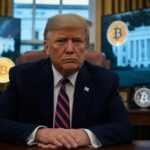Now Reading: What Will Happen When It Expires?
-
01
What Will Happen When It Expires?
What Will Happen When It Expires?
:max_bytes(150000):strip_icc()/GettyImages-2207589742-adbaad88f1ab49f08885fedf68b54361.jpg?ssl=1)
:max_bytes(150000):strip_icc():format(jpeg)/GettyImages-2207589742-adbaad88f1ab49f08885fedf68b54361.jpg)
Key Takeaways
- President Donald Trump’s 90-day pause on the “Liberation Day” tariffs expires on July 9.
- When the deadline passes, the U.S. could re-impose “reciprocal” tariffs on numerous countries, which would be a major drag on the economy.
- However, the deadline is highly likely to be extended, at least for countries negotiating deals with the U.S., according to comments from White House officials.
There are eight days left until July 9, when President Donald Trump’s 90-day pause on ‘Liberation Day’ tariffs expires.
Unless something changes, the massive, double-digit tariffs on dozens of countries that Trump announced on April 2 will take effect at midnight when Trump’s self-imposed deadline arrives. Trump put the tariffs on ice a week after they were announced, after financial markets went into a tailspin, giving countries time to negotiate them down.
The approaching deadline could be crucial for the economy. Trade experts have predicted that if the pause expires and the tariffs go into effect at the levels announced in April, the economy could fall into a recession.
Where Things Stand
The deadline is most important for relationships with countries targeted by “reciprocal” tariffs. Trump imposed a 10% baseline tariff on most countries, even those with whom the U.S. runs a trade surplus instead of a deficit. However, countries like Vietnam, Cambodia, and dozens of others were hit with additional reciprocal tariffs because the U.S. imports more than it exports to those countries, creating a trade deficit.
So far, only one country has reached a deal with the U.S. The U.S. and Britain made a preliminary agreement to lower some mutual trade barriers, including reduced tariffs on British cars. Britain was never targeted with a higher “reciprocal” tariff.
The U.S. has also reached a deal with China, but that agreement only removed trade barriers that were set up after the Liberation Day announcement—namely, China’s restriction on exports of key “rare earth” minerals and some export controls the U.S. had imposed in retaliation.
Trade experts say negotiating multiple deals on such a short timeline is a tall order since trade negotiations normally take years to finalize. However, Trump told reporters on Friday that the U.S. may just send letters to certain countries without further negotiation.
“We have 200 countries plus,” Trump said in a press conference on Friday. “We’ve talked to many of the countries, and we’re just going to tell them what they have to pay to do business in the United States, and it’s going to go very quickly.”
Deadline Could Be Extended
In recent days, White House officials have suggested the deadline could come and go without tariffs being imposed, at least for some countries.
Trade issues could be “wrapped up by Labor Day,” Treasury Secretary Scott Bessent told Fox News Friday. He had previously said the U.S. would postpone the deadline for countries negotiating in good faith while talks continue.
On Thursday, White House Press Secretary Karoline Leavitt told reporters the July 9 deadline was “not critical” and “could be extended.”
Several crucial trading partners face separate deadlines already. Trump has threatened to raise tariffs on the European Union to 50% on July 9 if they don’t reach a deal, and tariffs on China could go up to 145% if additional agreements are not made by August 12.
Trade Deals Could Leave Some Tariffs In Place
Even if the White House strikes deals with other countries, some import taxes could remain in place, including the 10% baseline tariff announced April 2, as well as the 25% tariff on steel and metal from most countries, a 25% tariff on foreign cars, and further tariffs on pharmaceuticals, lumber, copper, and computer chips that are in the works.
Forecasters are unsure how high tariffs will be in the long run, and on which countries and products. The uncertainty surrounding tariffs has had serious effects on the economy in and of itself. Businesses have curtailed expansion plans, and the Federal Reserve has held off on cutting interest rates, while they wait to see at what level Trump ends up setting the tariffs.













:max_bytes(150000):strip_icc()/GettyImages-2151617978-311f7ee5709d4fbca94c78741e01110e.jpg?w=1024&resize=1024,1024&ssl=1)

:max_bytes(150000):strip_icc()/GettyImages-2205883906-edf4003dda674f7bb2cc30d27f53cb80.jpg?w=1024&resize=1024,1024&ssl=1)











:max_bytes(150000):strip_icc()/GettyImages-2151617978-311f7ee5709d4fbca94c78741e01110e.jpg?w=150&resize=150,150&ssl=1)



